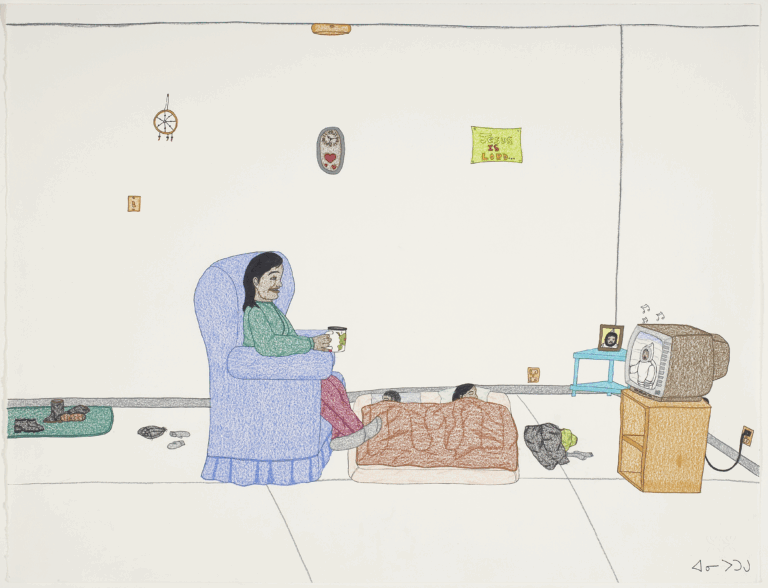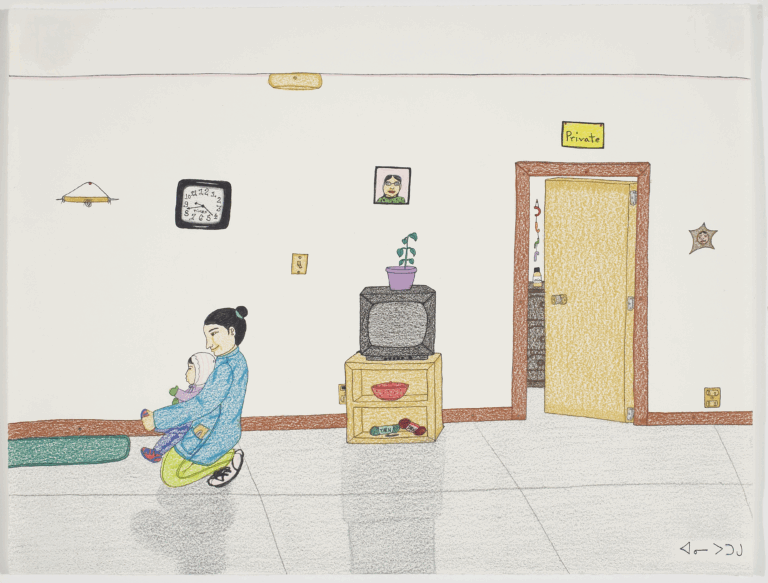This National Indigenous History Month, we’re honoured to share an artist profile on Annie Pootoogook and her drawings in Glenbow’s art collection.
Annie Pootoogook (1969–2016) is one of the most celebrated Inuit artists of the twenty-first century. In the early 2000s, she achieved national and international fame. In 2006, she had a solo exhibition at The Power Plant Contemporary Art Gallery in Toronto, showing a huge range of her drawings. Later that year, she was invited to participate in the Glenfiddich Artists in Residence in Dufftown, Scotland, and she won the Sobey Art Award, one of Canada’s most prestigious prizes for contemporary artists. More exhibitions followed: in 2007, her drawings were included in documenta 12 in Kassel, Germany, and a touring exhibition of her work was shown across Canada and at the National Museum of the American Indian in New York.
With each exhibition and critical accolade, Pootoogook’s work became better known. Many people were stunned by the subjects in her drawings. Reflecting on how people responded to her drawings, Inuk art historian and curator Heather Igloliorte observed, her art “brought in new audiences, and new understandings of what Inuit art could be, while showing the North to the South in a manner it had never been seen before. … Her art challenged viewer expectations of igloos and dog teams and instead revealed our “matchbox” houses, laminate-floored and sparsely decorated; the Northern Store with its refrigerators lined with freezer-burned frozen dinners; the quiet activity of the printshop [at Kinngait Studios]; or lazy afternoons spent watching trashy daytime television imported from far away.”[1] Similarly, Inuk writer Norma Dunning commented, “I felt like she moved Inuit art into the present day … She was someone who made me sigh with relief because her art showed the everyday existence of Inuit.”[2] Pootoogook wanted her art to represent her life: in a 2006 documentary about her art, she stated, “I didn’t see any igloos in my life … Only Ski-Doo, Honda, the house, things inside the house.”[3]


Pootoogook’s drawings At Home Watching TV and Preparing to Go Out reflect this larger theme in her art. Both works are filled with carefully drawn images of the things inside the house. At Home Watching TV shows a woman relaxing in a living room, enjoying a television program as two children nap nearby. Pootoogook’s composition is spare, but she has included several details of the room, from the outlets and light switch to a family photo on a side table and mittens and snowpants laid out on the floor. Similar details also appear in Preparing to Go Out: the outlets, light switch, TV and cabinet, and green doormat suggest the same room inspired both drawings, but Preparing to Go Out shows a moment of greater family activity, as a woman holds a toddler close to help them put on shoes. This combination of activity and everyday details recurs again and again in Pootoogook’s work, as do the carefully consistent, delicately shaded pencil crayon colours.
Pootoogook came from Kinngait, a community in Nunavut where art is profoundly connected to everyday life. Since 1959, artmaking in the community has centred on Kinngait Studios, an organization run by the community cooperative. Reflecting on Kinngait’s importance for Inuit art, Inuk curator Krista Zawadski has written, “For Inuit, art is inherent in our everyday lives. When we sew clothing, it is a work of art in its complex design, and beautiful to look at. When we build an iglu, it is a feat of engineering and a work of art. … for Inuit, art has always been present in our culture, technology, language, and stories. But it was not until settlement that Inuit began to engage in the art market by creating art with the intention of it being sold and displayed.”[4] Artists at Kinngait Studios were pivotal in developing Inuit art in new media, including works on paper that were purchased by thousands of people in Canada and abroad. Many of Pootoogook’s family members were part of this movement. Describing her family, Kinngait artist Jimmy Manning explained, “Annie Pootoogook was the daughter of the late Eegyvudluk Pootoogook and Napachie Pootoogook, both artists themselves. She came from a great artistic background, which included her uncles Qaqaq and Kiugak Ashoona, as well as Kananginak Pootoogook. Annie revered her famous grandmother Pitseolak Ashoona.”[5] In 2006, Pootoogook declared, “I am a third-generation artist,” later noting, “I have to follow my grandma and my mom, so that’s why I do it.”[6] For her, making art was as connected to her family as it was to her community.
Pootoogook’s legacy for contemporary Inuit art was tremendous. In 2017, Kinngait artist and community leader Pingwartok Ottokie declared, “Our artists have always reflected on the Inuit way of life in their work, but the unique perspective of Annie Pootoogook was truly redefining. Her studies of contemporary Kinngait were sometimes irreverent, occasionally humorous, and very often challenging. Annie dared to break traditional artistic moulds, while at the same time sharing important stories. The history of Inuit art owes Annie a great deal for her courage and daring.”[7] Igloliorte has also emphasized how Pootoogook changed understandings of Inuit art: “She captured the attention of the international art world and held it for several years, keeping the door open for other Inuit artists to also enter in the process.”[8] In bringing together tradition and contemporary life, in drawing subjects both startling and familiar, Pootoogook created an extraordinarily engaging body of work that continues to invite reflection on contemporary Inuit art today.
References
[1] Heather Igloliorte, “Annie Pootoogook: 1969–2016,” Canadian Art, September 27, 2016.
[2] Norma Dunning, “Annie Pootoogook,” in Early Days: Indigenous Art from the McMichael (Kleinburg: McMichael Canadian Art Collection, 2023), 313.
[3] Annie Pootoogook, quoted in Robert Everett-Green and Gloria Galloway, “A Remarkable Life,” The Globe and Mail, September 30, 2016.
[4] Krista Zawadski, “A Slice of Inuit Art in Iningat Ilagiit,” in Worlds on Paper: Drawings from Kinngait (Kleinburg: McMichael Canadian Art Collection, 2025), 30.
[5] Jimmy Manning, “Annie Pootoogook (1969 – 2016),” Inuit Art Quarterly, December 14, 2016, https://www.inuitartfoundation.org/iaq-online/annie-pootoogook-tribute.
[6] Annie Pootoogook, quoted in Everett-Green and Galloway, “A Remarkable Life,” and Nancy Tousley, “North Star,” Calgary Herald, January 21, 2007.
[7] Pingwartok Ottokie, “West Baffin Eskimo Co-operative President’s Foreword,” in Annie Pootoogook: Cutting Ice (Fredericton: Goose Lane Editions, 2017), 17.
[8] Igloliorte, “Annie Pootoogook: 1969–2016.”
